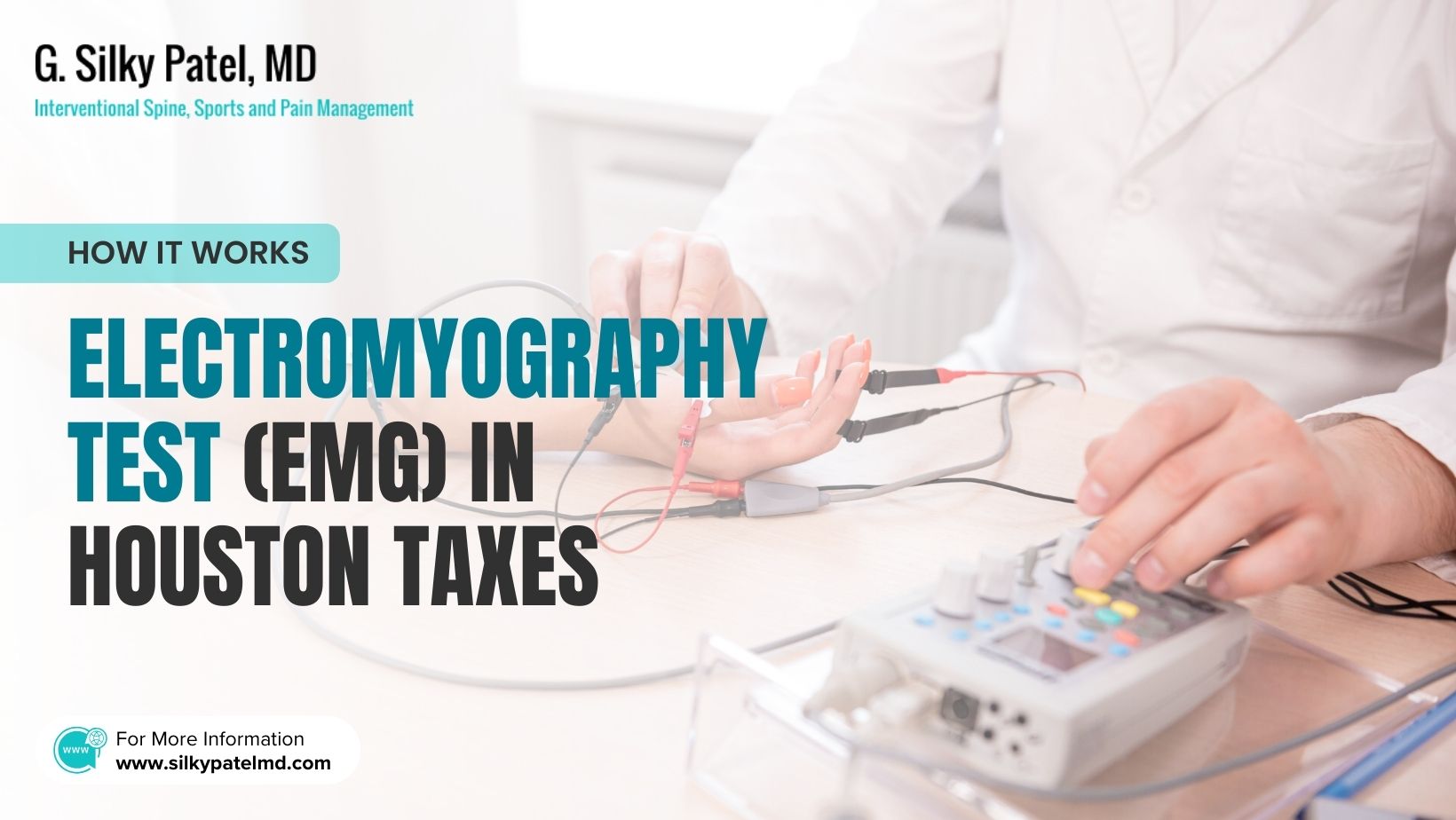Table of Contents
ToggleElectromyography Test is one of the most valuable diagnostic tools when leg pain, tingling, or weakness won’t go away. If you’re living in Houston or nearby areas like Katy, Sugar Land, Memorial City, or The Woodlands, chances are you’ve heard about this test but might not fully understand how it works or why it’s ordered.
When the sciatic nerve is irritated, the pain can travel from your lower back down through your legs, making everyday movement a struggle. In such cases, imaging alone may not explain the full story. That’s where Dr. Silky Patel, a double board-certified pain medicine specialist, steps in. She uses advanced testing methods to pinpoint nerve dysfunction so that treatment plans address the root cause instead of just symptoms.
By the end of this guide, you’ll understand not only what an electromyography test does but also why it matters for sciatica. You’ll also learn what to expect before, during, and after the procedure, and how Dr. Patel brings clarity to patients across Houston who are searching for lasting relief.
Electromyography Test: How It Works in Plain Language
What is Electromyography Test
At its core, an electromyography test measures the electrical activity in your muscles. Muscles normally send out signals when they contract or rest. When a nerve that controls those muscles is irritated, such as in cases of sciatica, the electrical patterns change. By placing fine recording electrodes into specific muscles, Dr. Silky Patel can see exactly how those signals behave and determine whether a nerve root in your spine is being compressed.
This test answers important questions that imaging can’t always solve. For example, an MRI may show a disc bulge, but an EMG reveals whether that bulge is actually affecting the nerve’s function. That level of detail is often the missing piece in diagnosing nerve-related pain in Houston patients.
EMG vs. Nerve Conduction Study
Often, an electromyography test is paired with a nerve conduction study. While the EMG looks at the muscle’s electrical activity, the nerve conduction study checks how quickly and efficiently your nerves carry signals. Together, these tests show whether symptoms are due to nerve damage, muscle disorder, or both. Dr. Patel uses this dual approach when sciatica or radiculopathy symptoms raise questions that require a precise answer.
What is EMG Test Used to Diagnose
One of the most common questions patients ask is: what is EMG test used to diagnose? Beyond sciatica, it can detect conditions such as peripheral neuropathy, muscle inflammation, carpal tunnel syndrome, and even certain motor neuron diseases. In the case of low back pain with leg radiation, the test identifies whether the sciatic nerve is irritated or compressed, which is key for planning the right treatment path.
When EMG is Recommended Before or After Imaging
Not every case of nerve pain needs an EMG immediately. Sometimes imaging tests come first. However, if an MRI is inconclusive or doesn’t match the severity of symptoms, an electromyography test in Houston provides the missing data. Dr. Patel often recommends it when she wants to confirm whether nerve irritation is ongoing or if damage has already occurred. This helps patients avoid unnecessary procedures and directs treatment more efficiently.
EMG and Sciatica in Houston: Pinpointing Nerve Root Irritation
Sciatica often begins with a sharp, shooting pain that radiates down the leg. While imaging may show a disc herniation, it doesn’t always prove whether the nerve root is actually irritated. This is where an electromyography test becomes an indispensable tool for patients in Houston seeking clarity.
How EMG Helps Confirm Lumbar Radiculopathy
When sciatica is suspected, the electromyography test records how the lumbar nerve roots are functioning. By studying the electrical activity in muscles that correspond to the sciatic nerve, Dr. Silky Patel can confirm whether the nerve irritation is mild, moderate, or severe. This level of detail provides answers that guide tailored treatment plans instead of guesswork.
EMG vs. MRI vs. Clinical Exam for Sciatica
An MRI may reveal structural issues, while a physical exam highlights patterns of weakness or numbness. However, an EMG test in Houston bridges the gap by confirming if those structural findings are truly affecting nerve communication. This three-way approach ensures that sciatica is not only suspected but also proven through measurable changes in nerve function.
What Abnormal Patterns May Suggest
An electromyography test can show slowed recruitment of muscle fibers or spontaneous activity when the muscle should be at rest. These patterns often confirm nerve compression. For a patient dealing with sciatica in Houston, abnormal results may explain why pain persists despite medication or therapy, and they guide Dr. Patel in choosing advanced treatments such as targeted injections or nerve stimulation.
Electromyography Test Near Me: Access in Houston and Surrounding Areas
Patients often search for electromyography test near me when their symptoms reach a point where they can no longer be ignored. Houston and its nearby communities—such as Sugar Land, Katy, Cypress, and The Woodlands—offer access to advanced diagnostic care through Dr. Silky Patel’s clinic.
Same-Week Scheduling Options
Waiting weeks for answers prolongs uncertainty and pain. With efficient scheduling, patients can often secure an electromyography test in Houston within the same week. This means less delay between testing and beginning the right treatment for sciatica.
What to Bring and How to Streamline Your Visit
For the most accurate results, it’s helpful to bring a list of current medications, any imaging reports, and a record of symptoms. Dr. Patel uses this information alongside EMG results to piece together a complete diagnostic picture. This preparation helps ensure that the electromyography test answers the right questions the first time.
Parking, Directions, and Practical Tips for Houston Clinics
Locating the right office is an important part of planning. Clinics in West Houston, Memorial City, and nearby areas offer convenient parking and easy access from major highways. These details reduce stress on the day of testing, allowing patients to focus on understanding what is electromyography test and why it matters for their care.
By offering clear instructions, patient-centered care, and modern facilities, Dr. Silky Patel ensures that undergoing an electromyography test is not just a medical step but a pathway toward meaningful relief.
Preparing for an EMG Test
Preparation plays a big role in ensuring an accurate electromyography test. For patients in Houston, knowing how to get ready removes uncertainty and helps the process go smoothly.
Medications, Pacemakers, Stimulators, and Safety Disclosures
Before the test, Dr. Silky Patel will review your medical history to ensure everything is safe. Certain medications, like blood thinners, may influence the test, and implanted devices such as pacemakers or stimulators need to be noted in advance. By sharing this information, you help create the right environment for reliable results.
Skin Prep, Clothing, and Comfort Tips
On the day of your electromyography test, it’s best to avoid lotions or oils on the skin since they can interfere with electrode readings. Wearing loose, comfortable clothing makes it easier to reach the muscles being tested. Many Houston patients say that these simple steps reduce stress and make the process feel more natural.
Managing Anxiety and Expectations
It’s normal to feel nervous before a diagnostic procedure. Patients often search what is electromyography test online and worry about discomfort. The truth is that while you may feel a brief pinch or tingling, the test is generally well-tolerated. Dr. Patel walks every patient through the steps beforehand, making sure you understand what to expect and feel reassured from start to finish.
During the Electromyography Test: Step-by-Step Experience
Knowing what happens during the test takes much of the mystery away. Patients often arrive asking about the details of an EMG test in Houston, and once they hear the process explained clearly, their concerns usually ease.
Check-In, Positioning, and Skin Cleaning
The visit begins with check-in and a quick review of your history. You’ll then be positioned so that the target muscles are easy to access. The skin is gently cleaned to prepare for the electrode placement, ensuring that the recordings are as precise as possible.
Needle Electrode Recording: What You’ll Feel and Hear
During the electromyography test, fine sterile electrodes are placed into specific muscles. These act like microphones, picking up the electrical signals. You may hear the sound of your muscle activity translated into crackles or pops through the monitor. Patients often describe the sensation as a light pinch followed by pressure, but it passes quickly.
When a Nerve Conduction Study is Performed the Same Day
In many cases, a nerve conduction study is done alongside the EMG. Small surface electrodes stimulate a nerve and record how fast the signal travels. Together, these two tests provide a comprehensive picture of what is EMG test used to diagnose, especially for conditions like sciatica or peripheral neuropathy. Dr. Patel often performs both during the same visit to give patients in Houston answers without unnecessary delays.
Safety, Sensations, and Recovery After EMG
Many patients wonder what happens after an electromyography test and whether they can return to daily activities right away. The experience is usually simple and requires little downtime, especially when the procedure is performed under the care of Dr. Silky Patel in Houston.
Common Post-Test Soreness and Simple Care at Home
It’s normal to feel slight muscle soreness or tenderness where the electrodes were placed. This sensation is temporary and often fades within a few hours to a day. Gentle stretching or applying a warm compress usually helps, and patients are able to continue with work or errands without interruption.
Rare Risks and When to Contact Dr. Silky Patel’s Office
Although the electromyography test is safe, rare risks such as bruising or persistent discomfort can occur. If unusual swelling, pain, or signs of infection develop, contacting Dr. Patel’s office ensures proper guidance. Her experience with advanced testing in Houston provides patients confidence that even rare issues are addressed quickly.
Return to Normal Activity and Timing for Results Discussion
Most patients return to normal activity right after the test. You may feel curious about what is electromyography test results showing and how they will influence care. In many cases, Dr. Patel reviews the findings soon after the test or schedules a follow-up to explain them in detail. This ensures you have clear answers about what is EMG test used to diagnose and how the results relate to your sciatica symptoms.
Understanding Your EMG Results
The real value of an electromyography test lies in interpreting the results. Numbers and waveforms on a monitor don’t mean much until an experienced specialist like Dr. Silky Patel explains what they show about nerve and muscle function.
How Dr. Silky Patel Interprets Waveforms and Recruitment Patterns
During the electromyography test, muscles create waveforms that indicate how nerves are firing. Abnormal findings may include spontaneous activity when muscles are at rest or delayed recruitment when they contract. These details reveal whether nerve roots are compressed, irritated, or damaged, which is especially relevant for sciatica cases in Houston.
What Results Mean for Sciatica Treatment Planning
Patients often search EMG test in Houston to understand whether their symptoms truly stem from nerve root problems. Test results help confirm if the sciatic nerve is involved and to what extent. Based on these findings, Dr. Patel may recommend conservative measures, targeted injections, or advanced therapies such as nerve stimulation. This way, treatment matches the severity and nature of the condition instead of relying only on imaging.
If Results Are Normal but Symptoms Persist: Next Steps
Sometimes the electromyography test shows normal activity, even when symptoms are strong. In such cases, Dr. Patel looks beyond the test to uncover other causes. Additional imaging, lab work, or diagnostic injections may be used to complete the picture. Understanding what is electromyography test and its limitations ensures that patients don’t feel discouraged by normal findings. Instead, it becomes one piece of a bigger diagnostic strategy to bring lasting relief.
Electromyography Test Cost in Houston
When planning for an electromyography test, patients often want clarity about expenses before moving forward. Understanding the financial side helps reduce stress and allows you to focus on care.
Electromyography Test Cost Factors
The cost of testing in Houston varies depending on several factors. These include the number of muscles being studied, whether a nerve conduction study is added, and the facility where the test is performed. Because every patient’s symptoms are unique, Dr. Silky Patel tailors the scope of testing to each case, which influences overall cost.
Insurance Verification, Prior Authorization, and HSA/FSA Use
Insurance coverage can play a major role in the final expense. Many carriers cover the procedure when it is medically necessary for conditions like sciatica. Before scheduling, Dr. Patel’s team verifies benefits and handles prior authorizations to avoid surprises. Patients also frequently use HSA or FSA accounts to manage electromyography test cost, making the process more manageable.
Transparent Estimates and Billing Support
Patients searching for electromyography test near me in Houston often mention confusion about medical billing. To address this, Dr. Patel’s office provides transparent estimates and walks patients through expected costs before the test. Clear explanations remove the uncertainty and ensure that financial planning does not interfere with medical decision-making.
EMG Test in Houston with Dr. Silky Patel: Expertise You Can Trust
Choosing where to have an EMG test in Houston matters just as much as the test itself. Accuracy, comfort, and expertise determine how useful the results will be for treating sciatica and other nerve conditions.
Double Board Certification and Leadership in Pain Medicine
Dr. Silky Patel is double board-certified in Physical Medicine & Rehabilitation and Pain Medicine. Her extensive training allows her to use the electromyography test as more than just a diagnostic tool—it becomes a roadmap for treatment that addresses both symptoms and underlying causes.
Academic and Hospital Leadership Background Informing Care
With years of experience as a Clinical Assistant Professor of Neurosurgery at UT–Houston and as Director of Pain Management at Houston Methodist West Hospital, Dr. Patel brings unique expertise to every evaluation. These roles sharpened her ability to interpret what is EMG test used to diagnose in complex cases, especially when imaging results and clinical symptoms don’t align.
Patient-Centered Communication and Follow-Through for Sciatica Relief
The most advanced test means little without a clear explanation. Dr. Patel takes time to walk each patient through what is electromyography test results showing and how those findings connect to treatment. This patient-centered approach builds trust and ensures that the path forward is based on understanding, not guesswork. For those in Houston and surrounding areas, having a trusted expert interpret EMG findings makes the journey toward sciatica relief far more certain.
A Note from Dr. Silky Patel
Living with sciatica or nerve-related pain can make each day feel unpredictable. The electromyography test is one of the most reliable ways to uncover how your nerves and muscles are truly functioning. My goal is to provide answers that give you peace of mind and a clear plan forward.
Whether you are searching for what is electromyography test, curious about what is EMG test used to diagnose, or wondering about electromyography test cost, I want you to feel confident that every detail will be explained in a way that makes sense. My approach combines advanced technology with patient-focused care so you can move past uncertainty and toward relief.
If you’re searching for an electromyography test near me in Houston or surrounding areas, I invite you to take the next step. Together, we can identify what’s causing your symptoms and create a personalized path to recovery.




